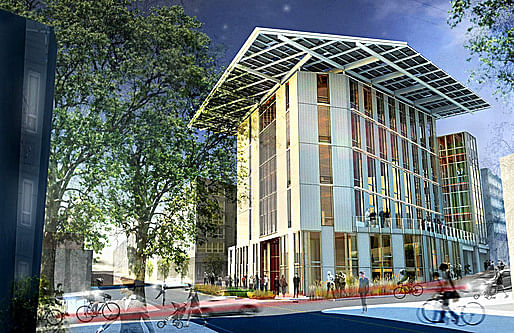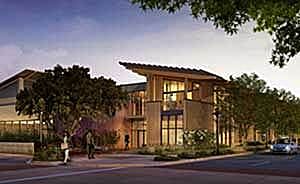

With several articles about the new Net-Zero Bullit Center in Seatle in the press NYTimes, (Citytank, and the NYTimes again to name a few) It seems a good time to shed some light on the Living Building Challenge. The Bullit Center is aiming for Living building certification and is the first office 'tower' to attempt such a rigorous certification (hence all the press interest). So the big question is.. what is the Living Building Challenge?
Tired of waiting for LEED and BREAM to get their act together, the creators of the Living Building Challenge went beyond checklists and recommendations. They double-dog dared not only the design community, but all of humanity, to wake up and smell the progress. Their lowest level of achievement is a net-zero building, from there a project can either be regenerative or restorative. So not only must a project require no recourse to renewable energy, but it should give back to the local community and/or eco-system. A technologically and socially advanced building that actually improves user experience and educates about sustainability… crazy right?
Sounds like just what the doctor ordered.
A Brief History of the Living Building Challenge
The Living Building Challenge is a philosophy, advocacy platform and certification program run by the International Living Future Institute which grew out of the Cascadia Region Green Building Council. The challenge was formally launched in 2006 but its roots go back to the EpiCenter Project in Boseman, Montana in the mid-nineties. During research for the EpiCenter Project, Jason F McLennan began conceptualizing a program that went further than LEED. In 2000, this idea was taken one step further by researching the economic and environmental implications of the Living Building concept along with levels of LEED® certification for the David and Lucille Packard Foundation (on a side note: the new Net Zero building designed by EHDD for the David and Lucille Packard Foundation is under construction and the design can be seen here http://www.ehdd.com/index.php?p=ehdd&flashid=2205 )
From here McLennan turned the theory of a living building into a codified standard. Version 2.0 of the Living Building Guide was recently issued and features a clear organizational system referred to as the petal system.

How Does it Work?
One of the main differences between LBC and LEED/BREAM is that it is based solely on actual recorded performance. A project cannot be granted a Living Building Challenge certificate for at least a year after completion to properly monitor energy use and occupant behavior. The challenge applies to all scales of projects from renovation to neighborhood/masterplanning. Ideally, projects register their intent to become Living Building Certified early to maximize the benefits of the resources of the Living Building Community. After completion the project must provide at least 9 months of consecutive net zero energy results. Meaning the project cannot use more electricity than in creates or more water than it collects over a 12 month period.
Furthermore the challenge recognizes and applauds efforts of transparency by project teams. The report by the project team for the Tyson Living Learning Center at Washington University ‘Getting to Net- Zero Energy: Lessons Learned from a Living Building Challenge’ won an AASHE award and was acknowledged by the Living Building Challenge for their efforts to educate future Living Building Challenge teams through their experiences.

The Red List
One of the more straightforward items in the Challenge Document is the red list. This is a list of materials that the Living Future Institute believes should be phased out of production due to toxicity/health concerns associated with components of the listed materials. Limiting or removing these materials from standards and specifications is a good first step any office can take to become more sustainable and move closer to creating a living building.
• Asbestos
• Cadmium
• Chlorinated Polyethylene and Chlorosulfonated Polyethlene43
• Chlorofluorocarbons (CFCs)
• Chloroprene (Neoprene)
• Formaldehyde (added)
• Halogenated Flame Retardants44
• Hydrochlorofluorocarbons (HCFCs)
• Lead (added)
• Mercury
• Petrochemical Fertilizers and Pesticides45
• Phthalates
• Polyvinyl Chloride (PVC)
• Wood treatments containing Creosote, Arsenic or Pentachlorophenol
Certified Projects
There will be a series of further posts about some of the certified projects, their design process and issues to overcome in achieving net zero.
Images:
Tyson Center: http://www.jetsongreen.com/2010/10/worlds-first-certified-living-buildings.html
Bullit Center: http://citytank.org/2011/05/21/passivhaus-could-have-made-bullitt-foundation-living-building-35-more-energy-intelligent/
David and Lucile Packard Foundation: http://blog.seriousenergy.com/?tag=energy-efficient-buildings
A discussion on everything to do with sustainable design. From renewable energy to implementing integrated design in professional practice. Case studies, article reviews and green building certification methods and additional resources will all be included.
2 Comments
nice overview of the living building challenge.
I was just at a conference about sustainability in higher education and spent lots of time talking with folks about the need to move beyond having carbon-neutral/net-zero energy as the end goal. The mainstream folks still haven't caught on, so our work is cut out...
What I like about the Living Building Challenge is that it embraces a much more holistic and comprehensive view of how we can create buildings that are GOOD for the environment, for society and for the economy. It is time we stopped building things that are merely LESS BAD.
Block this user
Are you sure you want to block this user and hide all related comments throughout the site?
Archinect
This is your first comment on Archinect. Your comment will be visible once approved.